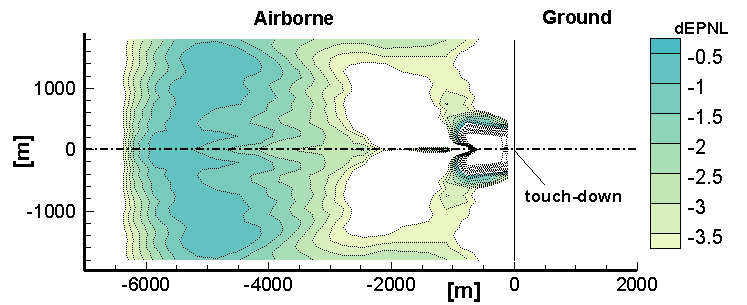Technical Note: Noise Footprint Analysis
FLIGHT-X acoustic capabilities
FLIGHT-X has a full suite of acoustics models to simulate almost every important detail of a modern airplane powered by gas turbine engines and turbopropellers.
In this technical note we show an example of how differences in aircraft operations lead to different noise footprints. These footprints depend on a wide variety of factors, such as aircraft configuration, operational considerations and atmospheric conditions (including winds).
Let us assume the aircraft performs an arrival/landing on a straight trajectory with a standard 3-degree approach slope. This operation will determine a noise footprint, interpreted as two-dimensional structured grid; each grid point is a noise receiver.
Now consider the same airplane performing a steep approach on a glide slope of 4.5 degrees. This operation will produce a different noise footprint. Calculating differences in noise metrics is not straightforward because of the log-scale, but in the case of EPNL we conventionally make a linear difference.
In the figure below we show the EPNL difference of an Airbus A320-211 airplane model on such a landing operation. Read the Full Report.
One of the things to consider is that whilst there is noise reduction under the flight track and in the immediate vicinity, some displaced locations may in fact suffer an increase in noise. This is due to directivity effects, as well as changes in airspeed and overall drag. The two flight operations do NOT have the same airspeed, and flap positions are not exactly the same.

Another possibility is to displace the landing, where possible, in order to increase the source-receiver distance.
FLIGHT-X will determine the best flight configuration for each final approach, and the acoustics module will fly those trajectories to produce similar noise footprints.
A great variety of noise assessments are possible, including the effects on propulsion noise, airframe noise, awakening functions, EPNL, SEL, PNLT, onset rate, etc.
